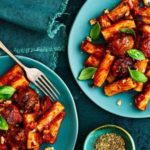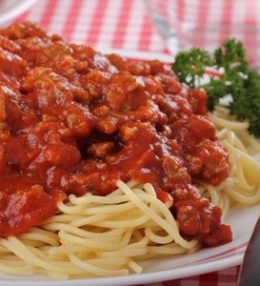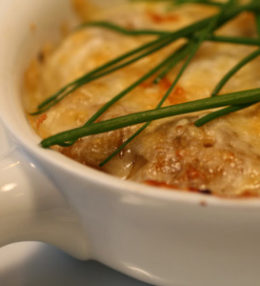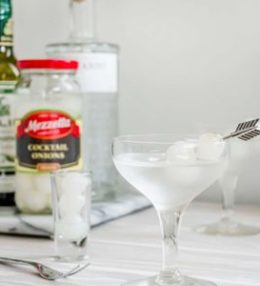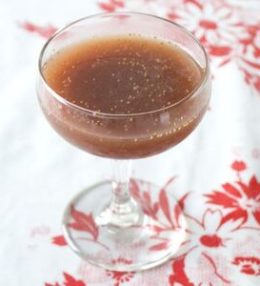Why It Works
- Processing onions and red peppers to a fine paste and then allowing the paste to drain (a classic technique in Armenian cooking) provides a deep base of flavor to the losh kebabs, without making them overly wet.
- Tomato paste, red pepper paste, and allspice further bump up the flavor of these ground meat patties.
- The addition of powdered gelatin and panko breadcrumbs keeps the meat patties juicy and tender.
- Dimpling the patties prevents ballooning as they cook over the heat of the grill.
While Armenian grilled meats—or khorovats, which just means “grilled” in Armenian—are most associated with the skewered chunks of meats called shish kebab, Armenians are equally enamored with ground or minced meat patties on the grill. Whether at church bazaars and picnics, or my own family’s backyard gatherings, you never really see one without the other.
These grilled, spiced ground meat kebabs go by a few different names, depending upon how they are formed and grilled (the meat mixture and seasonings are essentially the same, whatever the shape). Lula or lule kebabs—lule means “rolled”—are formed into sausage-shaped logs (skewered or freeform) or into long, flat patties by pressing them onto special flat, sword-like skewers. But in New England, where I grew up, Armenians instead make losh kebab, which are round, freeform patties exactly like hamburgers, except with more zing to them.
Serious Eats / Andrew Janjigian
Where shish kebab gets marinated and coated in a flavorful elixir made from onion, red wine, tomato paste, salt, and pepper, losh kebabs are seasoned (similarly) from the inside. Recipes of course vary from region to region and household to household; my own is based upon one from the family grill chief, my dad. (He’s considered such a local authority on Armenian grilled meats that he’s long been the foreman of our church’s event kebab-making crew, even though he should have been allowed to retire from that position years ago.) My losh kebab making technique differs from my dad’s here and there, but the flavor and texture of the kebabs is 100% identical to his, since they are unrivaled.
The Meat
Losh kebabs can be made from beef or lamb; the choice is up to you, depending upon your preference. (Armenians love lamb, but they make losh kebab out of beef as often as lamb.) Though almost no home cooks do so nowadays, the traditional approach for making losh and lule kebabs was to painstakingly mince the meat with a knife, which divides it finely and evenly without bashing it to a paste. This creates the ideal texture in a ground-meat kebab. That said, the quality of the meat and the consistency of the grind make a difference in the result. So use the freshest, best-quality meat you can get here. And while it is not essential, if you can, get it freshly ground from your butcher, especially because that means it will be slightly coarser and closer to the ideal texture than most prepackaged ground meats.
The Seasonings
Losh kebabs are almost always seasoned with onion, red bell pepper, parsley, tomato paste, salt, and pepper. My only additions to this lineup are a touch of allspice, a warm spice commonly used with Armenian meat dishes, and mild red pepper paste, which combines the depth of tomato paste with the fruity flavor of red chiles, often used in ground meat patties too. Red pepper paste can be found at Middle Eastern grocery stores or online and is often labeled ‘biber salçasi’, since most brands come from Turkey.
Some people simply mince or dice the onion and bell pepper and combine them with the meat, but, like my dad, I prefer to first process them to a paste and then drain the paste of excess water in a sieve, which seasons the meat throughout while also ensuring they don’t make the mixture overly soft.
Making Losh Kebabs
There are three ways in which my losh kebab recipe diverges from that of my dad and most others. I’ve been a recipe developer for many years now, and I’ve created numerous grilled ground meat patties and burgers during that time, so I have a bunch of tricks up my sleeve to make them as good as they can be. The first two are textural, while the third is purely a matter of aesthetics.
Losh kebabs, like other ground meat kebabs, are cooked until they are nicely charred on the exterior and fully-cooked within (meaning to a food-safe internal temperature of 160˚F or above). Because they are not left rare at the core, like burgers often are, they can sometimes dry out. To prevent this, I like to add two common pantry items to the meat mixture: powdered gelatin and panko breadcrumbs. Both function similarly, by absorbing and retaining moisture both before and during cooking, but they work better when used in tandem rather than singly. The breadcrumbs add a touch of bulk to the mixture, which helps keep the patties loose-textured rather than dense; the gelatin gets sticky once moist, which binds the mixture together while also upping juiciness. A one hour or longer rest before grilling the losh kebabs gives both ingredients time to activate for maximum effect.
Serious Eats / Andrew Janjigian
To my losh kebabs resembling burgers, flat on the top and bottom, I dimple them slightly during shaping so that they don’t inflate into footballs when grilled. Ground meat patties expand as they cook, since their fibers shrink when heated, which causes their lateral exterior to cinch up like a belt. Making a depression in the top of the patty before cooking ensures they end up flat, despite this effect.
Unlike shish kebabs, which require an intense, close-set fire for rapid charring without overcooking, losh kebabs can be cooked over any standard hot grill setup, like other burgers and meat patties. Flare-ups can be a problem, so be sure to move them around the grill if they occur, to avoid scorching.
Like shish kebabs, I recommend lining the vessel you place the cooked losh kebabs in with a pita or two, which will soak up the juices they shed as they rest before serving. Not only will that keep the exterior of the meat from softening, the breads make for an enhanced sort of wrapper for the patties, a treat for whomever gets dibs on them.
Losh Kebabs (Armenian Grilled Meat Patties) Recipe
- 1 medium yellow onion (about 8 ounces; 225g), cut into 2-inch pieces
- 1 large red bell pepper (about 8 3/4 ounces; 250g), stemmed, seeded, and cut into 1-inch pieces
- 1/3 cup (12g) minced fresh flat-leaf parsley
- 1 tablespoon (15g) mild biber salçasi pepper paste (see note)
- 1 tablespoon (15g) tomato paste
- 2 teaspoons (6g) Diamond Crystal kosher salt; for table salt, use half as much by volume or the same weight
- 1/2 teaspoon ground allspice
- 1/2 teaspoon freshly ground black pepper
- 1 1/2 teaspoons unflavored gelatin
- 2 pounds (900g) ground beef or lamb, at least 15% fat, or a 50/50 combination (see note)
- 1/3 cup (20g) panko breadcrumbs
- Pita bread, for serving (see note)
-
In the bowl of the food processor fitted with a metal blade, combine onion and bell pepper and process until a smooth paste forms, 30 to 45 seconds, scraping down sides of bowl as needed. Transfer mixture to a fine mesh strainer set over a medium bowl and allow to drain, about 15 minutes, pressing on solids with a rubber spatula to remove as much liquid as possible. Transfer onion-red pepper mixture to a large bowl, discarding any liquid.
Serious Eats / Andrew Janjigian
-
Add parsley, red pepper paste, tomato paste, salt, allspice, pepper, and gelatin to bowl and stir until uniform. Add ground meat and breadcrumbs and knead with your hands until mixture is thoroughly combined and feels slightly sticky, about 2 minutes.
Serious Eats / Andrew Janjigian
-
Divide mixture into 8 equal portions (about 5 ounces; 140g each) and place on a parchment- or foil-lined rimmed baking sheet. Gently shape each one into a patty about 3 1/2 inches wide and approximately 3/4 inch thick. Using three or four fingers, create a dimple by pushing down in the center of each patty. The dimple should be about 1/4 inch deep and 2 inches wide. Cover baking sheet with plastic wrap and refrigerate for at least 1 hour or up to 24 hours.
Serious Eats / Andrew Janjigian
-
Light one chimney full of charcoal. When all the charcoal is lit and covered with gray ash, pour out and arrange the coals on one side of the charcoal grate. Set cooking grate in place, cover grill, and allow to preheat for 5 minutes. Alternatively set burners on a gas grill to the highest heat setting, cover, and preheat for 15 minutes. Clean and oil cooking grate.
Serious Eats / Andrew Janjigian
-
Line a shallow serving bowl with one or two pita breads and set aside. Place patties on grill (directly over coals if using charcoal). Cook (covered if using gas) until patties are browned on the bottom and release easily from the grill, 4 to 7 minutes. Flip and continue to cook until browned on second side and meat registers 160˚F (71˚C), about 6 minutes longer. (If flare-ups occur, move patties around grill to avoid scorching.) Transfer patties to serving bowl, tent loosely with foil, and let rest for 2 minutes. Serve, passing remaining pita on the side.
Serious Eats / Andrew Janjigian
Special Equipment
Grill (charcoal or gas)
Notes
Biber salçasi can be found in Middle Eastern grocery stores or online. If unavailable, increase tomato paste to 2 tablespoons and add 1/2 teaspoon Aleppo pepper or 1 teaspoon sweet paprika.
Freshly-ground beef or lamb from your butcher, with a loose, coarse texture, works best here.
The pita used to line the serving platter soaks up juices from the cooked meat and is meant to serve as a tasty treat for the grill cook or anyone else, wrapped around pieces of meat.
Make-Ahead and Storage
Losh kebab is best enjoyed immediately. Leftovers can be refrigerated in an airtight container and reheated gently, or sliced and served cold in sandwiches.
Why It Works Processing onions and red peppers to a fine paste and then allowing the paste to drain (a classic technique in Armenian cooking) provides a deep base of flavor to the losh kebabs, without making them overly wet.Tomato paste, red pepper paste, and allspice further bump up the flavor of these ground meat patties.The addition of powdered gelatin and panko breadcrumbs keeps the meat patties juicy and tender.Dimpling the patties prevents ballooning as they cook over the heat of the grill. While Armenian grilled meats—or khorovats, which just means “grilled” in Armenian—are most associated with the skewered chunks of meats called shish kebab, Armenians are equally enamored with ground or minced meat patties on the grill. Whether at church bazaars and picnics, or my own family’s backyard gatherings, you never really see one without the other. These grilled, spiced ground meat kebabs go by a few different names, depending upon how they are formed and grilled (the meat mixture and seasonings are essentially the same, whatever the shape). Lula or lule kebabs—lule means “rolled”—are formed into sausage-shaped logs (skewered or freeform) or into long, flat patties by pressing them onto special flat, sword-like skewers. But in New England, where I grew up, Armenians instead make losh kebab, which are round, freeform patties exactly like hamburgers, except with more zing to them. Serious Eats / Andrew Janjigian Where shish kebab gets marinated and coated in a flavorful elixir made from onion, red wine, tomato paste, salt, and pepper, losh kebabs are seasoned (similarly) from the inside. Recipes of course vary from region to region and household to household; my own is based upon one from the family grill chief, my dad. (He’s considered such a local authority on Armenian grilled meats that he’s long been the foreman of our church’s event kebab-making crew, even though he should have been allowed to retire from that position years ago.) My losh kebab making technique differs from my dad’s here and there, but the flavor and texture of the kebabs is 100% identical to his, since they are unrivaled. The Meat Losh kebabs can be made from beef or lamb; the choice is up to you, depending upon your preference. (Armenians love lamb, but they make losh kebab out of beef as often as lamb.) Though almost no home cooks do so nowadays, the traditional approach for making losh and lule kebabs was to painstakingly mince the meat with a knife, which divides it finely and evenly without bashing it to a paste. This creates the ideal texture in a ground-meat kebab. That said, the quality of the meat and the consistency of the grind make a difference in the result. So use the freshest, best-quality meat you can get here. And while it is not essential, if you can, get it freshly ground from your butcher, especially because that means it will be slightly coarser and closer to the ideal texture than most prepackaged ground meats. The Seasonings Losh kebabs are almost always seasoned with onion, red bell pepper, parsley, tomato paste, salt, and pepper. My only additions to this lineup are a touch of allspice, a warm spice commonly used with Armenian meat dishes, and mild red pepper paste, which combines the depth of tomato paste with the fruity flavor of red chiles, often used in ground meat patties too. Red pepper paste can be found at Middle Eastern grocery stores or online and is often labeled ‘biber salçasi’, since most brands come from Turkey. Some people simply mince or dice the onion and bell pepper and combine them with the meat, but, like my dad, I prefer to first process them to a paste and then drain the paste of excess water in a sieve, which seasons the meat throughout while also ensuring they don’t make the mixture overly soft. Making Losh Kebabs There are three ways in which my losh kebab recipe diverges from that of my dad and most others. I’ve been a recipe developer for many years now, and I’ve created numerous grilled ground meat patties and burgers during that time, so I have a bunch of tricks up my sleeve to make them as good as they can be. The first two are textural, while the third is purely a matter of aesthetics. Losh kebabs, like other ground meat kebabs, are cooked until they are nicely charred on the exterior and fully-cooked within (meaning to a food-safe internal temperature of 160˚F or above). Because they are not left rare at the core, like burgers often are, they can sometimes dry out. To prevent this, I like to add two common pantry items to the meat mixture: powdered gelatin and panko breadcrumbs. Both function similarly, by absorbing and retaining moisture both before and during cooking, but they work better when used in tandem rather than singly. The breadcrumbs add a touch of bulk to the mixture, which helps keep the patties loose-textured rather than dense; the gelatin gets sticky once moist, which binds the mixture together while also upping juiciness. A one hour or longer rest before grilling the losh kebabs gives both ingredients time to activate for maximum effect. Serious Eats / Andrew Janjigian To my losh kebabs resembling burgers, flat on the top and bottom, I dimple them slightly during shaping so that they don’t inflate into footballs when grilled. Ground meat patties expand as they cook, since their fibers shrink when heated, which causes their lateral exterior to cinch up like a belt. Making a depression in the top of the patty before cooking ensures they end up flat, despite this effect. Unlike shish kebabs, which require an intense, close-set fire for rapid charring without overcooking, losh kebabs can be cooked over any standard hot grill setup, like other burgers and meat patties. Flare-ups can be a problem, so be sure to move them around the grill if they occur, to avoid scorching. Like shish kebabs, I recommend lining the vessel you place the cooked losh kebabs in with a pita or two, which will soak up the juices they shed as they rest before serving. Not only will that keep the exterior of the meat from softening, the breads make for an enhanced sort of wrapper for the patties, a treat for whomever gets dibs on them. Losh Kebabs (Armenian Grilled Meat Patties) Recipe 1 medium yellow onion (about 8 ounces; 225g), cut into 2-inch pieces 1 large red bell pepper (about 8 3/4 ounces; 250g), stemmed, seeded, and cut into 1-inch pieces 1/3 cup (12g) minced fresh flat-leaf parsley 1 tablespoon (15g) mild biber salçasi pepper paste (see note) 1 tablespoon (15g) tomato paste 2 teaspoons (6g) Diamond Crystal kosher salt; for table salt, use half as much by volume or the same weight 1/2 teaspoon ground allspice 1/2 teaspoon freshly ground black pepper 1 1/2 teaspoons unflavored gelatin 2 pounds (900g) ground beef or lamb, at least 15% fat, or a 50/50 combination (see note) 1/3 cup (20g) panko breadcrumbs Pita bread, for serving (see note) In the bowl of the food processor fitted with a metal blade, combine onion and bell pepper and process until a smooth paste forms, 30 to 45 seconds, scraping down sides of bowl as needed. Transfer mixture to a fine mesh strainer set over a medium bowl and allow to drain, about 15 minutes, pressing on solids with a rubber spatula to remove as much liquid as possible. Transfer onion-red pepper mixture to a large bowl, discarding any liquid. Serious Eats / Andrew Janjigian Add parsley, red pepper paste, tomato paste, salt, allspice, pepper, and gelatin to bowl and stir until uniform. Add ground meat and breadcrumbs and knead with your hands until mixture is thoroughly combined and feels slightly sticky, about 2 minutes. Serious Eats / Andrew Janjigian Divide mixture into 8 equal portions (about 5 ounces; 140g each) and place on a parchment- or foil-lined rimmed baking sheet. Gently shape each one into a patty about 3 1/2 inches wide and approximately 3/4 inch thick. Using three or four fingers, create a dimple by pushing down in the center of each patty. The dimple should be about 1/4 inch deep and 2 inches wide. Cover baking sheet with plastic wrap and refrigerate for at least 1 hour or up to 24 hours. Serious Eats / Andrew Janjigian Light one chimney full of charcoal. When all the charcoal is lit and covered with gray ash, pour out and arrange the coals on one side of the charcoal grate. Set cooking grate in place, cover grill, and allow to preheat for 5 minutes. Alternatively set burners on a gas grill to the highest heat setting, cover, and preheat for 15 minutes. Clean and oil cooking grate. Serious Eats / Andrew Janjigian Line a shallow serving bowl with one or two pita breads and set aside. Place patties on grill (directly over coals if using charcoal). Cook (covered if using gas) until patties are browned on the bottom and release easily from the grill, 4 to 7 minutes. Flip and continue to cook until browned on second side and meat registers 160˚F (71˚C), about 6 minutes longer. (If flare-ups occur, move patties around grill to avoid scorching.) Transfer patties to serving bowl, tent loosely with foil, and let rest for 2 minutes. Serve, passing remaining pita on the side. Serious Eats / Andrew Janjigian Special Equipment Grill (charcoal or gas) Notes Biber salçasi can be found in Middle Eastern grocery stores or online. If unavailable, increase tomato paste to 2 tablespoons and add 1/2 teaspoon Aleppo pepper or 1 teaspoon sweet paprika. Freshly-ground beef or lamb from your butcher, with a loose, coarse texture, works best here. The pita used to line the serving platter soaks up juices from the cooked meat and is meant to serve as a tasty treat for the grill cook or anyone else, wrapped around pieces of meat. Make-Ahead and Storage Losh kebab is best enjoyed immediately. Leftovers can be refrigerated in an airtight container and reheated gently, or sliced and served cold in sandwiches.
Losh Kebabs (Armenian Grilled Meat Patties)



